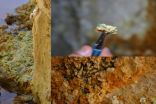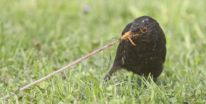(Press-News.org) Researchers at the Centre of Astrobiology have identified microorganisms that live inside salt deposits in the acidic and ferrous environment of the Tinto River in Huelva, Spain. The extreme conditions of these microniches appear to be similar to those of the salt deposits on Mars and Jupiter's moon, Europa. This possibility should be borne in mind on missions operating in these places, such as Curiosity.
The high doses of radiation, lack of moisture and extreme temperature and pressure on the surface of Mars make the development of life difficult. Within this hostile environment, scientists are searching for "friendlier" niches that could encourage life. One of the candidates is the salt deposits.
A team from the Centre of Astrobiology (CAB, INTA-CSIC) has analysed this kind of environment on Earth: the salt deposits associated to a mineral with sulphur and iron named natrojarosite. It can be found in the Río Tinto basin in Huelva and is very similar to one detected on Mars: jarosite. Its presence reveals the past or present existence of water.
"The salt deposits are good 'hosts' for biological remains and even life itself in extreme circumstances," as outlined to SINC by Felipe Gómez, coauthor of the study published in the 'Planetary and Space Science'.
"The reason is that conditions in this environment remain less adverse than those of their surroundings given that they provide protection from radiation for example, and they keep moisture levels higher than outside," explains the researcher.
With the help of microscopic techniques and molecular ecology, the team has discovered a film of bacteria and algae living in salt 'microniches' invisible to the naked eye. Up to five different morphologies have been found of microorganisms belonging to the Dunaliella and Cyanidium genera.
The deposits analysed have been formed by layers each with a width of just a few millimetres. They make up a "completely different" ecosystem to the strange environment of Río Tinto.
"The precipitated minerals could only have been formed in such an acidic environment like this one and it is still even home to microbial communities in development. In order words, here they find their ideal environment," says Gómez.
According to the study, "the discovery of these protected microniches in one of Mars' analogue on Earth, like Río Tinto, is an important step in evaluating the habitability potential of the red planet."
NASA's Mars Global Surveyor probe has already detected alluvial fan-shaped salt formations on the Martian surface and scientists believe that that they could exist below the frozen ocean of one of Jupiter's satellites, Europa.
"From the astrological point of view, salt deposits are of great importance and should be considered when searching for life on space exploration missions, like the current Curiosity rover mission on Mars," concludes Gómez. In fact, salt deposits of astrobiological interest have been found not far from where the NASA rover is.
On Earth the CAB team has also studied extreme salt environments in Chott el Djerid Lake (Tunisia) and under the Atacama Desert (Chile).
INFORMATION:
References:
F. Gómez, J.A. Rodríguez-Manfredi, N. Rodríguez, M. Fernández-Sampedro, F.J. Caballero-Castrejón, R. Amils. "Habitability: Where to look for life? Halophilic habitats: Earth analogs to study Mars habitability". Planetary and Space Science 68 (1): 48, 2012.
The saline hiding places for bacteria in Río Tinto could be like those on Mars
2013-01-11
ELSE PRESS RELEASES FROM THIS DATE:
New treatment could combat deadly chemical agents
2013-01-11
An enzyme treatment which could neutralise the effects of lethal chemicals responsible for the deaths of hundreds of thousands of people across the world has been developed by experts at the University of Sheffield.
Organophosphorus agents (OP) are used as pesticides in developing countries and acute poisoning is common because of insufficient control, poor storage, ready availability, and inadequate education amongst farmers.
It is estimated about 200,000 people die each year across the world from OP poisoning, through occupational exposure, unintentional use and misuse, ...
UGA discovery promises to improve drugs used to fight cancer, other diseases
2013-01-11
Athens, Ga. – Even when at rest, the human body is a flurry of activity. Like a microscopic metropolis locked in a state of perpetual rush hour traffic, the trillions of cells that make us who we are work feverishly policing the streets, making repairs, building new structures and delivering important cargo throughout the bustling organic society.
For everything to work properly there must be something to organize and direct the various workers. Enter protein kinases. Like specialized traffic signals, this huge class of proteins is critical for many aspects of cell communication, ...
Researchers use iPSCs to define optimal treatment for managing life-threatening arrhythmias
2013-01-11
Researchers used induced pluripotent stem cells (iPSCs) derived from a young patient with Long QT syndrome (LQTS), a congenital heart disorder, to determine a course of treatment that helped manage the patient's life-threatening arrhythmias. The results, which appear in The Journal of General Physiology, could lead to improved treatments for LQTS and other channelopathies, diseases caused by disturbed ion channel function.
iPSCs—adult cells that have been genetically reprogrammed to function like embryonic stem cells—provide a valuable tool for studying diseases and ...
Clamorous city blackbirds
2013-01-11
This press release is available in German.
Animals have developed a variety of strategies for dealing with increasing noise pollution in their habitats. It is known, for example, that many urban birds sing at a high pitch to differentiate their song from the low-frequency sound of road traffic. However, as scientists from the Max Planck Institute for Ornithology discovered, this is just a useful side effect. The real reason for this behaviour is that songs at a higher pitch are also automatically louder. The birds can make themselves heard far better in city noise ...
Lady beetle diet influences its effectiveness as biocontrol agent
2013-01-11
This press release is available in Spanish.
By examining what lady beetles eat, U.S. Department of Agriculture (USDA) scientists are learning more about the movement of these beneficial insects in farm fields—and whether they'll actively feed on crop pests.
Agricultural Research Service (ARS) entomologist Jonathan Lundgren at the North Central Agricultural Research Laboratory in Brookings, S.D., and former ARS entomologist Michael Seagraves were part of a team of ARS and university scientists that examined how a lady beetle's diet alters its feeding patterns and ...
Nearby dwarf galaxy and possible protogalaxy discovered
2013-01-11
Peering deep into the dim edges of a distorted pinwheel galaxy in the constellation Ursa Major (the Great Bear), astronomers at Case Western Reserve University and their colleagues have discovered a faint dwarf galaxy and another possible young dwarf caught before it had a chance to form any stars.
Within the faint trails of intergalactic traffic, the researchers also found more evidence pointing to two already known dwarf galaxies as probable forces that pulled the pinwheel-shaped disk galaxy known as M101 out of shape.
M101 is the dominant member in a group of 15 ...
Game-based economics research explains why we roll the dice on flu shots
2013-01-11
With 41 states having reported widespread and severe outbreaks of flu this season, timely new research sheds light on why less than half of the American population has gotten a flu shot.
Despite widespread knowledge that a vaccine is the best way to reduce the chances of catching and spreading the flu, even three of the four main TODAY show anchors recently admitted they had not gotten a flu shot (until they did so live on the air).
Using an online computer game that simulates the spread of an infectious disease among its players, researchers at Wake Forest University ...
Experts aim to redefine healthcare and research ethics
2013-01-11
In what they acknowledge as a seismic shift in the ethical foundation of medical research, practice and policy, a prominent group of interdisciplinary healthcare experts, led by bioethicists at Johns Hopkins, rejects an ethical paradigm that has guided the American system since the 1970s and calls for morally obligatory participation in a "learning healthcare system" more in step with the digital age. The group has authored a pair of articles outlining their arguments and proposal for a new ethical framework, which appear in a special report from The Hastings Center Report, ...
Epigenomic abnormalities predict patient survival in non-Hodgkins lymphoma
2013-01-11
Think of the epigenome like a giant musical mixing board, turning up or down the expression of various genes. A University of Colorado Cancer Center study published today in the journal PLOS Genetics shows that in cancer, not only can genes themselves go bad, but abnormal changes in the epigenetic mixing board can unfortunately change the expression of these genes. Researchers hope to play the role of sound engineers, controlling these harmful epigenomic changes to turn down cancer itself or perhaps sensitize cancers to existing drugs.
The epigenome's primary tool – ...
A saliva gland test for Parkinson's disease?
2013-01-11
SAN DIEGO – New research suggests that testing a portion of a person's saliva gland may be a way to diagnose Parkinson's disease. The study was released today and will be presented at the American Academy of Neurology's 65th Annual Meeting in San Diego, March 16 to 23, 2013.
"There is currently no diagnostic test for Parkinson's disease," said study author Charles Adler, MD, PhD, with the Mayo Clinic Arizona and a Fellow of the American Academy of Neurology. "We have previously shown in autopsies of Parkinson's patients that the abnormal proteins associated with Parkinson's ...


